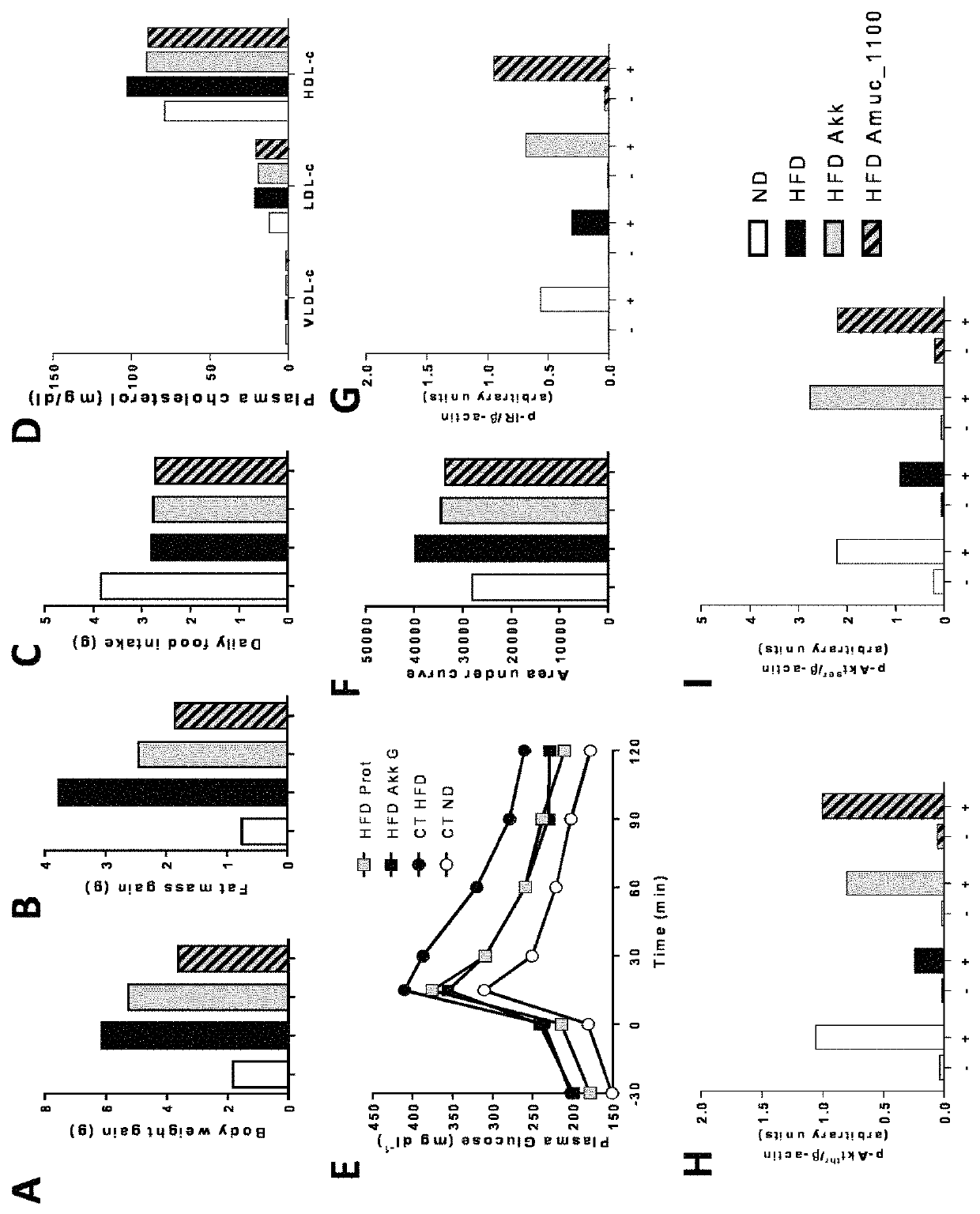Use of a polypeptide for effecting immune signalling and/or affecting intestinal barrier function and/or modulating metabolic status
a polypeptide and immune signalling technology, applied in the field of gut mucosal immune system, gut mucosal barrier, pharmaceutical, food or feed compositions comprising polypeptides, can solve the problems of disease or other undesirable conditions, allergies, and the host's gut mucosal barrier may be vulnerable to a wide range, so as to enhance the risk of developing diabetes, increase the risk of acute pancreatitis, and high triglyceride levels
- Summary
- Abstract
- Description
- Claims
- Application Information
AI Technical Summary
Benefits of technology
Problems solved by technology
Method used
Image
Examples
example 1
n of Bacteria Genetically Modified to Produce Amuc-1100 Proteins
Method:
[0106]The polynucleotide encoding the mature Amuc-1100 (nucleotide sequence of SEQ ID NO:2) was cloned into E. coli TOP10 with a C-terminal His-Tag under control of the inducible T7 promoter of pET28-derivatives and introduced into E. coli BL23(DE3) for overproduction. For this purpose an ATG start codon was added to the nucleotide sequence of SEQ ID NO; 2, so that the resulting polypeptide started with the amino acid sequence MIVNS. All constructs were confirmed by Sanger sequence analysis. The constructs carrying the overexpressed Amuc-1100 resulted in overproduction of soluble Amuc-1100 proteins that were purified to apparent homogeneity by Ni-column affinity chromatography and used in a concentration of 100-300 ug / ml. The purified Amuc-1100 was used to generate antibodies in rabbits essentially as described previously (Reunanen J et al. 2012, Appl Environ Microbiol 78:2337-44).
Results:
[0107]The results show t...
example 2
on and Stimulation of the TLR2 Signalling Pathway
Method:
[0108]In order to test the ability of Amuc-1100 to bind the TLR2 and other TLR receptors and subsequently stimulate the TLR2 and other TLR signalling pathways, reporter cell lines expressing TLR2 and TLR4 receptors were prepared. The ability of Amuc-1100 to bind cell lines expressing TLR2 or TLR4 and thereafter stimulate the TLR2 and / or TLR4 signaling pathway in said cells was tested in vitro by measuring the production of NK-kB from the reporter cells.
[0109]Briefly, hTLR2 and hTLR4 cell lines (Invivogen, CA, USA) were used. Stimulation of the receptors with the corresponding ligands activates NF-κB and AP-1, which induces the production of Secreted embryonic alkaline phosphatase (SEAP), the levels of which can be measured by spectrophotometer (Spectramax). All cell lines were grown and subcultured up 35 to 70-80% of confluency using as a maintenance medium Dulbecco's Modified Eagle Medium (DMEM) supplemented with 4.5 g / l D-glu...
example 3
on of Cytokine Release from Peripheral Blood Mononuclear Cells
Method:
[0111]The ability of Amuc-1100 to stimulate cytokine production or release from peripheral blood mononuclear cells (PBMCs) was tested in vitro. Briefly, peripheral blood of three healthy donors was received from the Sanquin Blood Bank, Nijmegen, The Netherlands. Peripheral blood mononuclear cells (PBMCs) were separated from the blood of healthy donors using Ficoll-Paque Plus gradient centrifugation according to the manufacturer's protocol (Amersham biosciences, Uppsala, Sweden). After centrifugation the mononuclear cells were collected, washed in Iscove's Modified Dulbecco's Medium (IMDM)+Glutamax (Invitrogen, Breda, The Netherlands) and adjusted to 0.5×106 cells / ml in IMDM+Glutamax supplemented with penicillin (100 U / ml) (Invitrogen), streptomycin (100 μg / ml) (Invitrogen), and 10% heat inactivated FBS (Lonza, Basel, Switzerland). PBMCs (0.5×106 cells / well) were seeded in 48-well tissue culture plates. For each don...
PUM
| Property | Measurement | Unit |
|---|---|---|
| concentration | aaaaa | aaaaa |
| pore size | aaaaa | aaaaa |
| concentrations | aaaaa | aaaaa |
Abstract
Description
Claims
Application Information
 Login to View More
Login to View More - R&D
- Intellectual Property
- Life Sciences
- Materials
- Tech Scout
- Unparalleled Data Quality
- Higher Quality Content
- 60% Fewer Hallucinations
Browse by: Latest US Patents, China's latest patents, Technical Efficacy Thesaurus, Application Domain, Technology Topic, Popular Technical Reports.
© 2025 PatSnap. All rights reserved.Legal|Privacy policy|Modern Slavery Act Transparency Statement|Sitemap|About US| Contact US: help@patsnap.com

